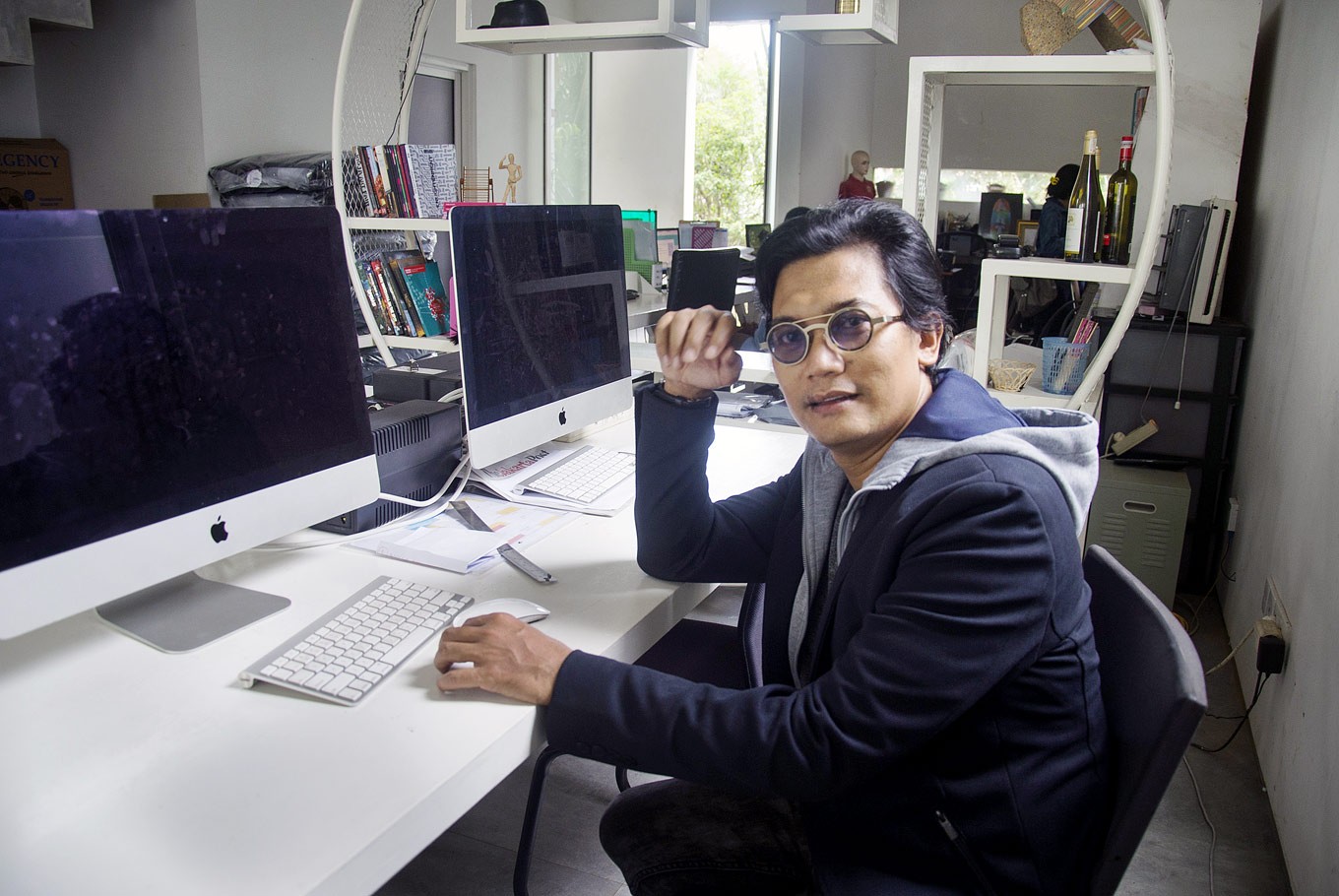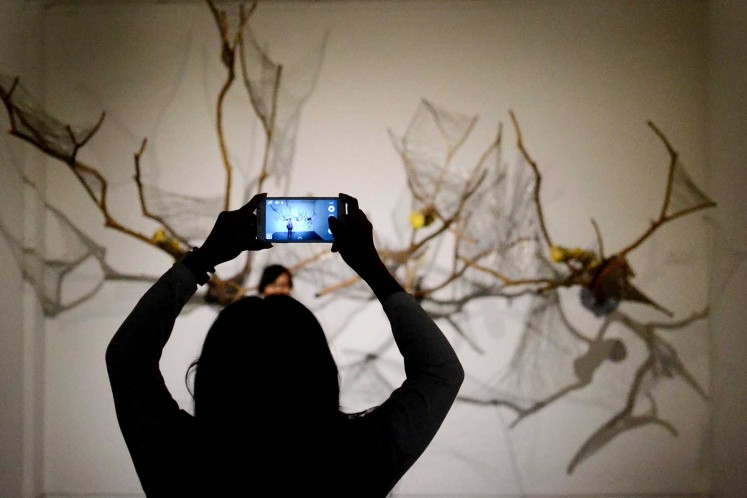Popular Reads
Top Results
Can't find what you're looking for?
View all search resultsPopular Reads
Top Results
Can't find what you're looking for?
View all search resultsHeri Pemad: The 'madman' behind ARTJOG
This man is the initiator of ARTJOG, an annual art fair in Yogyakarta that since 2008 has established itself as the largest contemporary art market and exhibition in the country.
Change text size
Gift Premium Articles
to Anyone
A
rt lovers and collectors in Indonesia often call him a madman for his stubborn traits and persistence in organizing art fairs despite repeatedly facing financial pressure.
“Only a madman does so,” they would say when they talk about art event organizer Herianto, or Heri Pemad as he is more popularly known.
This man is the initiator of ARTJOG, an annual art fair in Yogyakarta that since 2008 has established itself as the largest contemporary art market and exhibition in the country, drawing thousands of art enthusiasts who mark the event in their calendar.
This year, the event is set to run from May 4 to June 4, featuring 54 local and international artists including from the Philippines, Singapore, China and Australia.
However to date, which is year of the 11th ARTJOG, Pemad has collected a combined debt of about Rp 2 billion (US$145,269) from the previous events. Even for this year’s event, no deal has been made, but a main sponsor has agreed to fund Rp 5 billion.
Read also: ARTJOG: Window to Indonesian arts
“From the business’ point of view, such activity does not make sense, but I have a different view about this,” Pemad said at his house that also serves as his office for Heri Pemad Art Management, in Soboman, Yogyakarta.
He said apart from realizing idealism in the world of fine art in Indonesia, he and his fellow members of ARTJOG management have been enjoying indirect benefits from being the organizers of the event. Some, for example, were invited to become curators in Singapore or Australia. Some others become art event organizers in different cities.
He confirms that ARTJOG always experiences a financial deficit because the funds collected from sponsorship never exceed 20 percent of the total needed to organize the event.
To cope with the deficit, the organizing committee uses the income from entrance ticket sales, rental fees for the bazaar rooms and commission from artwork sales.
“Still, it cannot cover all the spending for the month long event that involves hundreds of people every day,” he said.
So, for this year’s event, he invites everyone to participate by donating whatever they can, such as wood, wire, cement, cloth, paper and food.
“This is what we call the Yogya art movement,” he said, adding that this is what has kept his spirit high.
Although he could not pay his debt to the stage vendors for previous events, when he returned to them asking for help, they agreed.
“This really touches me,” he said.
A display at ARTJOG 2016 is used as a backdrop by young visitors taking pictures. (The Jakarta Post/Stefanus Ajie)Such a spirit is also shared by the event’s proud volunteers, which comprise university students. The event’s management had to limit the number of volunteers allowed to participate because of the abundant number of applicants.
What also makes ARTJOG special is the displays at the art fairs, especially the outdoor ones, that many consider as not being less “mad” than Pemad’s “madness” as the organizer. It always invites people’s amazement given the lack of facilities and sponsorship.
Pemad has a bigger vision for this event.
“I want to make ARTJOG as big as the Centre Pompidou in France or Art Basel in Switzerland,” said the father of one who has regularly visited international art fairs.
Born in Sukoharjo, Central Java, on April 12, 1976, as Herianto, Pemad said he did not know why his fellow students at the Indonesian Institute of the Art (ISI) Yogyakarta started calling him Heri Pemad in 1997.
So, with pride, the recipient of the 2015 Adi Karya Rupa award from the Tourism Ministry and Creative Economy Agency started to sign his paintings with Pemad, although he never knew the meaning of the word. He later learned that the word pemad is Javanese slang meaning “mad”.
Pemad grew up with the values of hard work and was looked after by his uncle and grandfather, as his mother died not long after giving birth to him. He spent his childhood and teenage years in Sukoharjo in a farming and peddler family. He learned many things there about how to do business, farming, building relationships and friendships.
His painting skills were recognized early by his friends and teachers when he was at school. Back then, he was often asked to draw pictures of heroes or maps for his school.
After finishing senior high school, he moved to Yogyakarta to study fine art at the ISI Yogyakarta. Yet, he had to wait for three years until he was admitted to the ISI.
“While waiting, I worked whatever job was available to survive,” said Pemad, adding that he once worked as a sander in a furniture factory and as a street musician.
During his time at the ISI, he also helped senior artists in Yogyakarta by distributing exhibition invitations. This gave him an income as well as a chance to meet famous artists and exchange ideas.
It might be during this time that his passion in event organizing grew. After having the experience of helping to organize fine art exhibitions, he finally organized his own. Pemad soon realized that his passion was to bridge artists and art collectors. He dropped out of his studies and started organizing fine art exhibitions in 2001. He later established an art management company and created ARTJOG in 2007 and 2008, which was initially named Jogja Art Fair.
His hard work paid off. Thousands of people visit the contemporary art event annually. They not only come from Yogyakarta but also from other cities, thus contributing a great deal to the people’s economy in the city.
Pemad said funding has always been the main challenge of organizing ARTJOG. He expressed hope that the government will lend a hand to it, not just in terms of funding but also in terms of facilities, such as a representative exhibition building of international standards.
“Tell me where we can find a facility of international standards like that in Indonesia. Even Yogyakarta, known as the capital city of Indonesian fine art, does not have one,” Pemad said.
To make Jogja National Museum — the venue of ARTJOG — more representative, he said he had to spend Rp 800 million last year to fix the electricity installation, refurbish the toilets and mend the leaking roof. He said he did the same with the Yogyakarta Cultural Park when ARTJOG used it as a venue.
“I am therefore ready if ARTJOG is taken over by the government, but on condition that it has to be conducted according to its vision and mission and not just to disburse funds from the state budget,” Pemad said.












